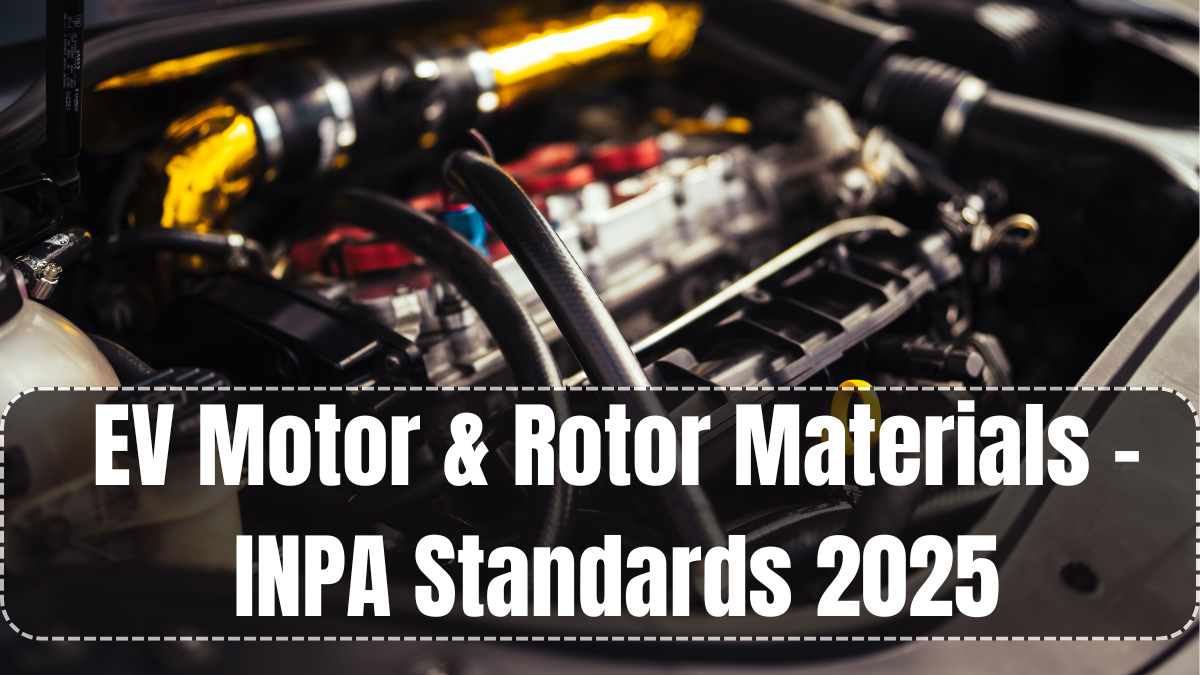Electric vehicles are at the forefront of India’s transportation revolution, and at the heart of every EV lies its motor and rotor system. As demand surges for energy-efficient, durable, and high-performance EVs, the Indian National Parts Authority (INPA) has introduced updated EV Motor Rotor Materials 2025 standards. These standards ensure that all components meet safety, performance, and sustainability benchmarks critical to India’s evolving EV ecosystem.
Rotor and stator materials influence everything from torque output to energy consumption. With rising adoption of electric two-wheelers, commercial EVs, and passenger cars, the need for precision-engineered, regulation-compliant motor materials has never been higher.

What’s Covered Under EV Motor Rotor Materials 2025
The EV Motor Rotor Materials 2025 framework defines approved materials, coating technologies, and design tolerances that must be followed by manufacturers and OEM suppliers.
Core categories include:
-
Stator laminations: Silicon steel, cobalt alloys
-
Rotor cores: Electrical steel with high magnetic permeability
-
Permanent magnets: Neodymium Iron Boron (NdFeB), Samarium Cobalt (SmCo)
-
Conductive materials: Copper or aluminum windings
-
Coatings and insulation: Epoxy resin, varnish for heat resistance
-
Cooling systems: Integrated materials for thermal transfer in liquid- or air-cooled motors
Each material used must pass performance, durability, and corrosion-resistance tests as per INPA-approved lab standards.
Key Updates in the 2025 Standards
The INPA’s latest revisions under EV Motor Rotor Materials 2025 were made to align with global trends, EV-specific challenges, and Indian climate conditions.
Notable updates include:
-
Mandatory use of high-efficiency electrical steel in both stator and rotor construction
-
Minimum coercivity levels for rare earth magnets to prevent heat-induced demagnetization
-
Standardized thickness and layering of laminations to reduce eddy current losses
-
Compliance with REACH and RoHS for imported materials
-
Guidelines for recyclable and lead-free insulation materials
These revisions help reduce motor noise, extend motor lifespan, and enhance energy efficiency in all weather conditions—especially during high summer loads and monsoons.
Impact on EV Manufacturers and Component Suppliers
The EV Motor Rotor Materials 2025 mandate impacts multiple stakeholders:
-
OEMs and Tier-1 Suppliers must redesign or verify rotor-stator configurations for compliance
-
Raw Material Suppliers need INPA-recognized certification for their steel and magnet alloys
-
Motor Assembly Units must update production SOPs and inspection routines
-
Importers are required to provide traceability documents for magnets and winding materials
Failure to comply can result in penalties, product recalls, or revocation of business licenses for motor system suppliers.
To ease this transition, INPA offers a material pre-approval process and maintains a registry of compliant suppliers.
Materials Driving EV Motor Efficiency in 2025
Here’s a look at the top-performing materials used in EV Motor Rotor Materials 2025, based on INPA insights:
| Material Type | Common Use | Properties |
|---|---|---|
| Grain-Oriented Steel | Rotor laminations | Low core loss, high magnetic flux |
| NdFeB Magnets | Permanent magnet rotors | High energy density, compact size |
| Samarium Cobalt | High-temperature EV motors | Superior thermal stability |
| Copper Windings | Stator and rotor windings | High conductivity, low resistance |
| Epoxy Resin Coating | Insulation and protection | Moisture-resistant, flame-retardant |
Indian EV brands like Tata, Ather, and Ola Electric are increasingly sourcing these materials domestically through INPA-certified suppliers to ensure local reliability and cost efficiency.
Sustainability and Recycling Mandates
The 2025 INPA framework for EV Motor Rotor Materials 2025 also includes key sustainability goals:
-
Mandatory documentation of magnet sourcing from ethical and conflict-free zones
-
Encouragement of aluminum alternatives where feasible to reduce copper dependency
-
Development of closed-loop recycling systems for rotor steel and magnets
-
Banning of hazardous substances like hexavalent chromium and lead-based insulation
-
Incentives for using recycled steel sheets in motor lamination stacks
These measures align with India’s broader EV battery and motor recycling policy expected to be enforced by 2026.
FAQs
What are the approved materials for EV rotors as per INPA 2025?
Approved materials include high-grade electrical steel, NdFeB or SmCo magnets, copper/aluminum windings, and certified epoxy coatings.
Are these standards mandatory for all EV manufacturers?
Yes, all domestic and imported EV motors sold in India must comply with INPA’s rotor and motor material guidelines from 2025 onward.
How do these materials affect motor performance?
They enhance energy efficiency, reduce heat loss, improve torque output, and ensure longer motor life under diverse driving conditions.
Is local sourcing of EV motor materials encouraged?
Yes, INPA offers tax incentives and fast-track certification for manufacturers sourcing materials from certified Indian suppliers.
Can recycled rotor materials be used?
Yes, if they meet the quality benchmarks defined in the INPA framework and are tested for structural and magnetic properties.
Click here to know more.
